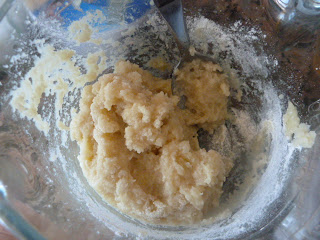These delicious soft cookies originated in Vila-Real, a beautiful city in Castelló, Spain, whose name could be translated to English as Royal Town . Anyway, as you can imagine they were not usually baked in a halogen oven traditionally...but the result shows it's not a bad idea to use our little glass kitchen companion.
INGREDIENTS
Boiled potatoes. Use your leftover tatters for a budget recipe.
Ground almonds (roughly the same volume as potatoes)
Sugar, approximately 5 tbsp (for the quantities in photos)
1 egg
PREPARATION
Put your potatoes in a bowl, add almonds and sugar.
Separate the egg and use the white as a liquid to form a soft dough. But don't use the whole of it at once; you can always add it gradually if your dough is too tough.
Should you accidentaly make your dough too soft, add more ground almonds. You can also add a little flour, but not overdo this.
Pinch small pieces out of the dough with your fingers, or use a tablespoon, and coat them in additional sugar.
Work quickly, since the mixture is quite sticky. Damp your fingers if necessary to shape the cookies.
Place the small balls on a greased mold (I use organic margarine) and make a small indentation in the center of each flattened piece with your finger.
Now use some of the egg yolk, beaten with a little sugar, to fill the small cavities. Don't use too much. You don't want it to overflow. Place the mold in the preheated halogen oven, on the high rack.
Use a temperature of 200ºC (approx. 390ºF) during 12-15 minutes, or until they are golden brown on the surface. Bottom will be white, but done. Here, the cookies rising during the baking process:
And the final result, still in the baking tray. Let them cool for 10 minutes and then carefully lift them with a knife. Place them on a cooling rack; enjoy them when completely cooled. They keep for 2-3 days in a tightly closed container.
INGREDIENTS
Boiled potatoes. Use your leftover tatters for a budget recipe.
Ground almonds (roughly the same volume as potatoes)
Sugar, approximately 5 tbsp (for the quantities in photos)
1 egg
PREPARATION
Put your potatoes in a bowl, add almonds and sugar.
Separate the egg and use the white as a liquid to form a soft dough. But don't use the whole of it at once; you can always add it gradually if your dough is too tough.
Should you accidentaly make your dough too soft, add more ground almonds. You can also add a little flour, but not overdo this.
Pinch small pieces out of the dough with your fingers, or use a tablespoon, and coat them in additional sugar.
Work quickly, since the mixture is quite sticky. Damp your fingers if necessary to shape the cookies.
Place the small balls on a greased mold (I use organic margarine) and make a small indentation in the center of each flattened piece with your finger.
Now use some of the egg yolk, beaten with a little sugar, to fill the small cavities. Don't use too much. You don't want it to overflow. Place the mold in the preheated halogen oven, on the high rack.
Use a temperature of 200ºC (approx. 390ºF) during 12-15 minutes, or until they are golden brown on the surface. Bottom will be white, but done. Here, the cookies rising during the baking process:
And the final result, still in the baking tray. Let them cool for 10 minutes and then carefully lift them with a knife. Place them on a cooling rack; enjoy them when completely cooled. They keep for 2-3 days in a tightly closed container.














